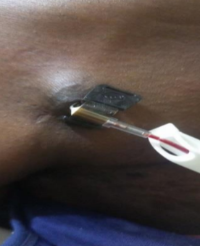Early experience with Chemoport Insertion and Management for Chemotherapy in a Tertiary Hospital, South-South, Nigeria-the COVID-19 Factor
Main Article Content
Abstract
Downloads
Article Details
Section

This work is licensed under a Creative Commons Attribution-NonCommercial-ShareAlike 4.0 International License.
This is an open-access article distributed under the terms ![]() This work is licensed under a Creative Commons Attribution-ShareAlike 4.0 International License.
This work is licensed under a Creative Commons Attribution-ShareAlike 4.0 International License.
How to Cite
References
1. Shah T, Vijay DG, Shah N, Patel B, Patel S, Khant N, Gothwal K. Chemoport Insertion-Less is More. Indian Journal of Surgical Oncology 2021;12(1):139-145
2. Yaacob Y, Nguyen DV, Mohamed Z, Ralib AR, Zakaria R, Muda S. Image-guided chemotherapy insertion by interventional radiologist: a single-centre experience on periprocedural complications. Indian J Radiol Imaging 2013; 23:121-125
3. Kim HJ, Yun J, Kim HJ, Kim KH, Kim SH, Lee SC, Bae SB, Kim CK, Lee NS, Lee KT, Park SK, Won JH, Hong DS. Safety and effectiveness of central venous catheterization in patients with cancer: prospective observational study. J Korean Med Sci 2010;25: 1748-1753
4. Kumar AH, Srinivasan NM, Thakkar JM, Mathew S.A prospective observational study of the outcome of central venous catheterization in 100 patients. Anesth Essays Res. 2013; 7:71-75
5. Vescia S, Baumgartner AK, Jacobs VR, Kiechle-Bahat M, Rody A, Loibl S, Harbeck N. Management of venous portal system in oncology: a review of current evidence. Ann Oncol 2008: 9-15
6. Teichgraber UK, Streitparth F, Cho CH, Benter T, Gebauer B. A comparison of clinical outcomes with regular and low profile totally implanted central venous port system. Cardiovasc Intervent Radiol 2009; 32:975-979
7. Biffi R, Orsi F, Pozzi S, Pace U, Bonomo G, Monfardini L, Della Vigna P, Rotmensz N, Radice D, Zampino MG, Fazio N, de Braud F, Andreoni B, Goldhirsch A. Best choice of central venous insertion site for the prevention of catheter related complications in adult patients who need cancer therapy: a randomized trial. Ann Oncol 2009; 20:935-940
8. Di Carlo I, Cordio S, La Greca G, Privitera G, Russello D, Puleo S, Latteri F. Totally implantable venous access devices implantable surgically: a retrospective study on early and late complications. Arch Surg. 2001; 136:1050-1053
9. Araujo C, Silva JP, Antunes P, Fernandes JM, Dias C, Pereira H, Dias T, Fougo JL, A comparative study between two central veins for the introduction of totally implantable venous access devices in 1201 cancer patients. Eur J Surg Oncol 2008; 34:222-226
10. Teichgraber UK, Kausche S, Nagel SN, Gebauer B. Outcome analysis in 3160 implantations of radiologically guided placement of totally implantable central venous port system. Eur Radiol 2011; 21:1224-1232
11. Babu KG, Suresh -Babu MC Lokanatha D, Bhat GR. Outcomes, cost comparison and patients’ satisfaction during long term central venous access in Cancer patients: experience from a tertiary care cancer institute in south India. Indian J Med Paediatr Oncol 2016; 37:232-238
12. McGee DC Gould MK. Preventing complications of central venous catheterization. N Engl J Med 2003; 348:1123-1133
13. Kim DH, Ryu DY, Jung HJ, Lee SS. Evaluation of complications of totally implantable central venous port system insertion. Exp Ther Med 2019;17: 2013-2018
14. Bishop L, Doughtery L, Bodenham A, Mansi J, Crowe P,
Kibbler C, Shannon M, Treleaven J. Guidance on the
insertion and management of central venous devices in
adults. Int J Lab Hematol 2007; 29:261-278
15. SafdarN, Maki DG. Risk of catheter related bloodstream
infection with peripherally inserted central venous
catheters used in hospitalised patients. Chest 2005;128:
489-495
16. Almhanna K, Pelley RJ, Thomas Budd G, Davidson J,
Moore HC. Subcutaneous implantable venous access
device erosion through the skin in patients treated with
anti-vascular endothelial growth factor therapy: a case
series. Anti-Cancer drugs 2008; 19:217-219
17. Lee AY. Cancer and thromboembolic disease: pathogenic
mechanisms. Cancer Treat Rev 2002; 28:137-140
18. Nakamura T, Sasaki J, Asari Y, Sato T, Torii S, Watanabe
M. Complications after implantation of subcutaneous
central venous port (PowerPort®). Ann Med Surg 2017;
17:1-6
19. Buba N. Complications of chemoport in children with
cancer: experience of 54,100 catheter days from a tertiary
cancer center of Southern India. South Asia J Cancer 2015;
4:143-145
20. Alexey Surov A, Stoevesandt D, Behrmann C, Wienke A.
Intravascular embolization of venous catheter-causes,
clinical signs, and management: a systemic
review.2009;33:677-685
21. Gibson F, Bodenham A.2013.Misplaced central venous
catheter applied anatomy and practical management. Br J
Anaesth 2013; 110:333-346
22. Verso M, Agnelli G. Venous thromboembolism associated
with long term use of central venous catheters in cancer
patients. J Clin Oncol 2003;213665-3675
23. Budis S, Calick D, Parrish D. misplacement of internal
jugular chemoport into the epidural space. ACS case review
2023:1-10


